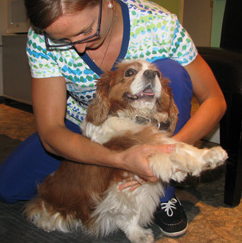Our pets are living longer now than they ever have before. Many attribute this to advances in veterinary medicine and the increased education owners have about caring for their animals. Regardless of the cause, the senior pet population is growing and owners are finding themselves searching for the best ways to keep their pets happy and healthy for as long as possible.
It is a fact that pets age faster than humans. Owners tend to want to think of their animals’ age in terms of human years, but there is no simple equation for this. According to the American Veterinary Medical Association, cats and small dogs are considered geriatric at the age of 7, whereas larger dog breeds reach the geriatric classification at the age of 6. Keep in mind, this is a simplified classification system and numerous variables must be taken into consideration when determining if an animal has reached geriatric status.
It is a common misconception that elderly pets require less attention and care versus younger, more active animals. Senior pets actually require increased care, including more frequent veterinary visits, possible diet and medication alterations, and even changes to their home environment. Geriatric pets should have semi-annual veterinary visits to catch and detect any illness or problems early.
A primary concern for senior pet owners is how to maintain their animal’s mobility and minimize the challenges associated with arthritic joints. Older pets, especially larger breeds, are prone to developing arthritis. Signs of arthritis include: difficulty getting up from a sitting or laying position, hesitancy to jump, run or climb stairs, favouring a limb, decreased activity, and hind end weakness.
When dealing with an arthritic pet, owners should take a three-pronged approach. First, visit your veterinarian to ensure your animal is diagnosed adequately and receives proper medications/supplements. Second, senior-proof your home. Hardwood floors and tile are slippery for pets and increase their likelihood of injury. Elderly pets struggle with balance and strength issues, which can be worsened if they do not have enough traction when moving around your home. A simple solution is to add carpet runners to your home or purchase non-slip dog socks/booties (if tolerated) to allow your older dog to move about with ease. Finally, make sure food and water are within easy reach and do not require trips up and down stairs. The third prong is one that many pet owners have yet to explore—have your animal receive therapeutic treatment. Chiropractic, massage, and laser therapy are very effective for animals suffering from arthritis. The benefits of these treatments are improved joint mobility, decreased muscle tightness, reduced pain and improved overall functioning. Many pet owners who explore these treatment options see positive results in their pets and often times will note decreased reliance on pain medications.
Caring for a senior pet can be difficult as no one wants to think about their pet passing. Instead of letting that worry you, let it be a reminder to live in the moment. Take the opportunity to cuddle up, take a walk together, and enjoy every moment you have with your pet.

